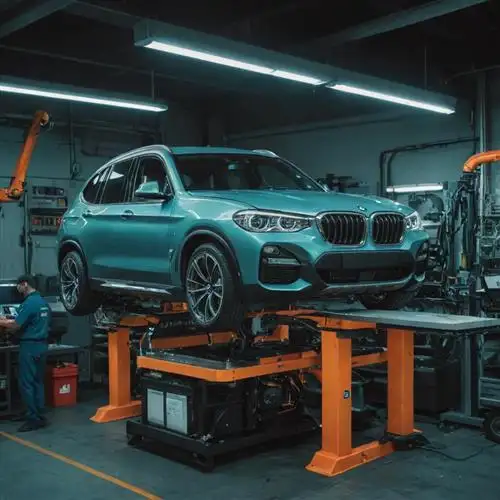
Understanding the BMW X3 Maintenance Schedule
Maintaining your BMW X3 is crucial to ensuring its longevity and optimal performance. The manufacturer-recommended maintenance schedule for the X3 is designed to keep your vehicle running smoothly and prevent costly repairs down the line. By adhering to this schedule, you can proactively address potential issues and extend the life of your beloved SUV.
The BMW X3 maintenance schedule is divided into several key intervals, each with its own set of recommended services. At the 10,000-mile mark, you should expect to have your vehicle's oil and filter changed, along with a thorough inspection of critical components. This inspection will cover everything from brake pads and rotors to the condition of your tires and suspension system.
Every 20,000 miles, your X3 will require more comprehensive maintenance, including the replacement of spark plugs, cabin air filters, and a comprehensive check of the engine, transmission, and driveline. It's also recommended to have the coolant system flushed and refilled at this interval to ensure optimal cooling performance.
The 30,000-mile service interval is a significant one for the BMW X3, as it involves the replacement of the engine air filter, fuel filter, and brake fluid. This is also an opportune time to have your vehicle's alignment checked and adjusted if necessary, ensuring your tires wear evenly and your steering remains precise.
At the 60,000-mile mark, your X3 will require even more extensive maintenance, including the replacement of the transfer case and differential fluids, as well as a thorough inspection of the entire vehicle's systems. This is a critical juncture in the life of your BMW, and it's essential to follow the manufacturer's recommendations to the letter.
DIY Brake Pad Replacement for the BMW X3
Replacing the brake pads on your BMW X3 may seem like a daunting task, but with the right tools and a little know-how, it's a job you can easily tackle yourself. Not only will this save you money, but it also gives you a sense of accomplishment and a deeper understanding of your vehicle's inner workings.
First and foremost, it's crucial to have the right tools on hand. You'll need a set of high-quality jack stands, a torque wrench, a caliper tool, and a brake pad installation tool. Make sure to refer to your owner's manual or consult with a professional to ensure you have the proper tools for your specific X3 model.
- Park your X3 on a level surface and engage the parking brake. Raise the vehicle with the jack stands, ensuring it's securely supported.
- Remove the wheels to gain access to the brake calipers. Be careful not to let the calipers hang from the brake lines, as this can damage the lines.
- Use the caliper tool to compress the piston, allowing you to remove the old brake pads. Make sure to inspect the caliper slides and clean them thoroughly before installing the new pads.
- Apply a thin layer of brake lubricant to the caliper slides and the backside of the new brake pads. This will help ensure smooth operation and prevent premature wear.
- Carefully insert the new brake pads, making sure they are properly aligned and seated in the caliper.
- Reinstall the caliper and secure it in place with the appropriate hardware. Tighten the caliper bolts to the manufacturer's specified torque settings.
- Repeat the process for the remaining wheels, ensuring that all brake pads are replaced evenly.
- Once all the brake pads have been replaced, lower the vehicle and take it for a short test drive to ensure the brakes are working correctly.
It's important to note that the brake pad replacement process may vary slightly depending on the specific model and year of your BMW X3. Always refer to your owner's manual or consult with a professional if you're unsure about any step in the process.
Mastering Oil Changes for the BMW X3
Performing oil changes on your BMW X3 is a crucial maintenance task that can extend the life of your vehicle's engine and keep it running smoothly. While it may seem like a daunting task, with the right tools and a bit of know-how, you can easily master the process. In this section, we'll dive deep into the specifics of changing the oil on your BMW X3, providing you with the knowledge and confidence to tackle this essential maintenance procedure.
First and foremost, it's important to use the recommended oil type and quantity for your BMW X3. The owner's manual will provide the exact specifications, but typically, the X3 requires a high-quality synthetic oil, such as 5W-30 or 5W-40. Depending on the model year and engine, the oil capacity can range from 4.5 to 6.9 quarts. Using the correct oil is crucial, as it ensures optimal lubrication and protection for your engine.
- Park your BMW X3 on a level surface and engage the parking brake. This will ensure the vehicle is stable and secure during the oil change.
- Locate the oil drain plug, typically located on the bottom of the oil pan. Place a large drain pan underneath to catch the used oil.
- Using the appropriate wrench or socket, loosen and remove the drain plug, allowing the old oil to drain completely.
- Once the oil has drained, replace the drain plug and tighten it securely.
- Locate the oil filter, which is usually accessible from the top or side of the engine. Use an oil filter wrench to loosen and remove the old filter.
- Apply a thin coat of fresh oil to the gasket of the new oil filter, then screw it on by hand until it is snug.
- Unscrew the oil fill cap and pour in the recommended amount of new oil, checking the dipstick to ensure the level is correct.
- Replace the oil fill cap and start the engine, allowing it to run for a few minutes to circulate the fresh oil.
- Recheck the oil level and top up if necessary.
It's also important to dispose of the used oil and filter properly, as they can be harmful to the environment if not disposed of correctly. Many auto parts stores and municipal recycling centers offer oil and filter recycling services.
In addition to the oil change itself, it's a good idea to perform a visual inspection of your BMW X3's engine components during the process. Look for any signs of leaks, wear, or damage, and address any issues you find. This proactive approach can help you stay ahead of potential problems and maintain the overall health of your vehicle.
Tire Rotation and Balancing for the BMW X3
Maintaining the tires on your BMW X3 is crucial for ensuring a smooth, safe, and efficient ride. Regular tire rotation and balancing are two essential practices that every X3 owner should be familiar with. Tire rotation involves moving the tires from one position to another on the vehicle, while balancing ensures that the weight of the tire and wheel assembly is evenly distributed.
Tire rotation is typically recommended every 5,000 to 7,500 miles, or as specified in your owner's manual. This process helps to even out the wear on your tires, leading to longer tread life and improved performance. When rotating the tires, it's important to follow the recommended pattern, which may vary depending on your vehicle's drivetrain (rear-wheel, front-wheel, or all-wheel drive). Consult your owner's manual or a trusted mechanic to ensure you're rotating the tires correctly.
Tire balancing, on the other hand, is necessary to address any imbalances in the tire and wheel assembly. Imbalanced tires can cause a range of issues, including uneven tread wear, vibrations, and increased fuel consumption. It's generally recommended to have your tires balanced every time you have them rotated or when you notice any changes in the vehicle's handling or ride quality.
The balancing process involves the use of specialized equipment to measure the weight distribution of the tire and wheel assembly. Small weights are then added to the wheel to counteract any imbalances, ensuring a smooth and even ride. This process is crucial for maintaining the longevity of your tires and providing a comfortable driving experience in your BMW X3.
Maintaining the BMW X3 Cooling System
The BMW X3 is a sophisticated and powerful vehicle, and its cooling system plays a vital role in ensuring the engine runs smoothly and efficiently. As an owner, it's crucial to understand the importance of properly maintaining this system to prolong the life of your vehicle and avoid costly repairs. In this article, we'll dive deep into the world of BMW X3 cooling system maintenance, providing you with the knowledge and insights you need to master this aspect of your vehicle's upkeep.
The BMW X3 cooling system is responsible for regulating the temperature of the engine, preventing overheating and ensuring optimal performance. This system consists of several key components, including the water pump, radiator, thermostat, and coolant hoses, all of which work together to circulate the coolant and dissipate heat. Regular inspections and maintenance of these components are essential to maintaining the overall health of your BMW X3's cooling system.
One of the most critical aspects of cooling system maintenance is ensuring the proper level and quality of the coolant. BMW recommends using a specific type of coolant, which is designed to work in harmony with the materials and components used in the X3's cooling system. It's important to follow the manufacturer's recommendations and never mix different types of coolant, as this can lead to chemical reactions and damage to the system.
In addition to checking the coolant level, it's also essential to inspect the coolant hoses for any signs of wear, cracking, or leaks. These hoses are responsible for transporting the coolant throughout the system, and if they fail, it can result in overheating and potential engine damage. Regularly inspecting the hoses and replacing them when necessary is a crucial preventative measure.
The water pump is another critical component of the BMW X3's cooling system. This pump is responsible for circulating the coolant throughout the engine, and if it fails, it can lead to overheating and a complete system breakdown. It's recommended to have the water pump inspected and replaced at the intervals specified in your owner's manual to ensure it continues to function properly.
The thermostat is another component that plays a vital role in the cooling system. This device is responsible for regulating the temperature of the coolant, ensuring it reaches the optimal operating temperature. If the thermostat fails, it can lead to the engine running too hot or too cold, both of which can have detrimental effects on the overall performance and longevity of the vehicle.
Finally, it's important to regularly flush and replace the coolant in your BMW X3. Over time, the coolant can become contaminated with impurities and lose its ability to effectively regulate the engine's temperature. Flushing the system and replacing the coolant at the recommended intervals is a simple yet essential maintenance task that can help extend the life of your vehicle's cooling system.
















